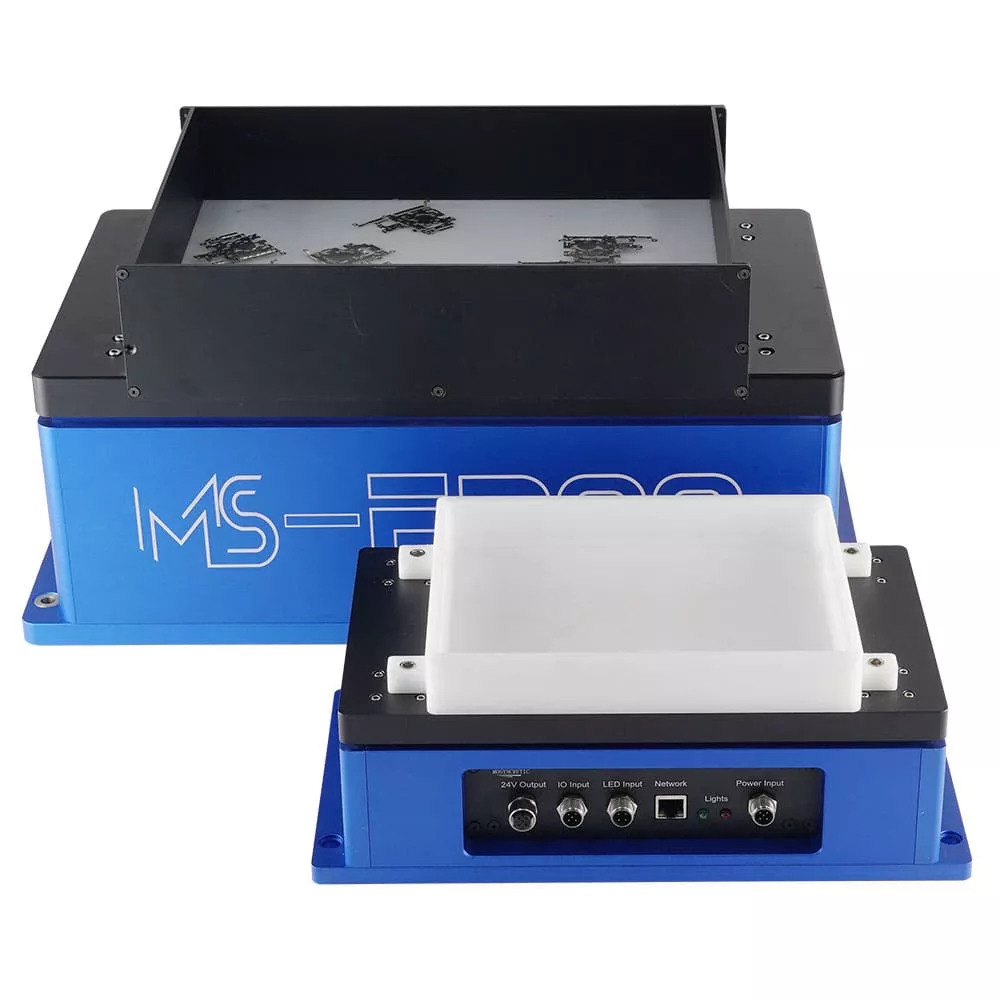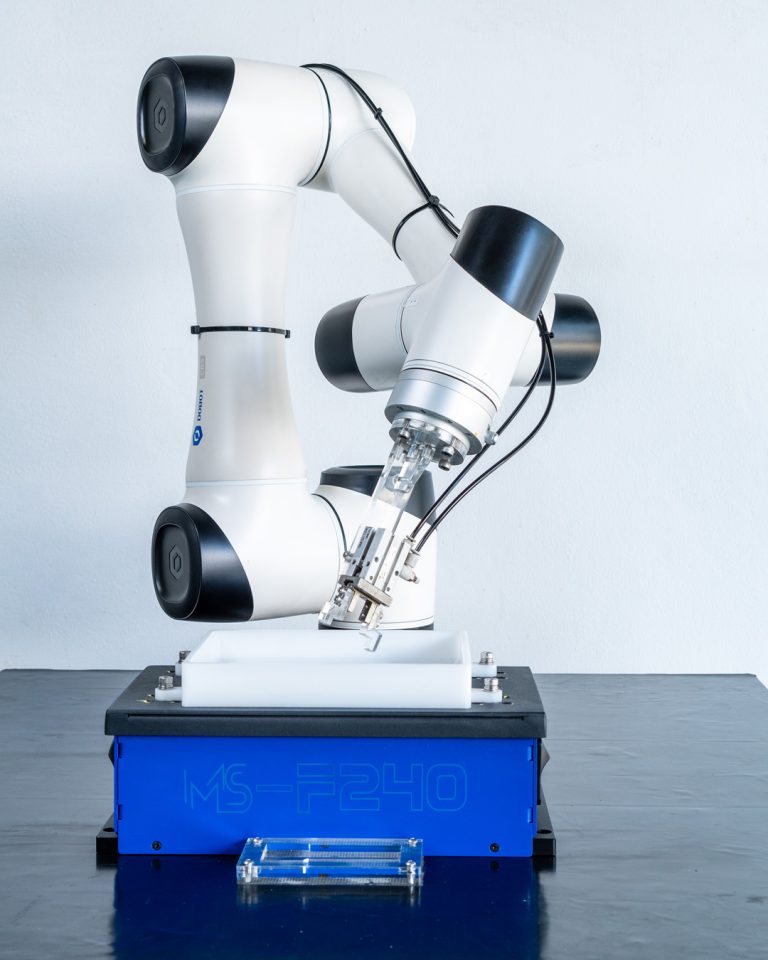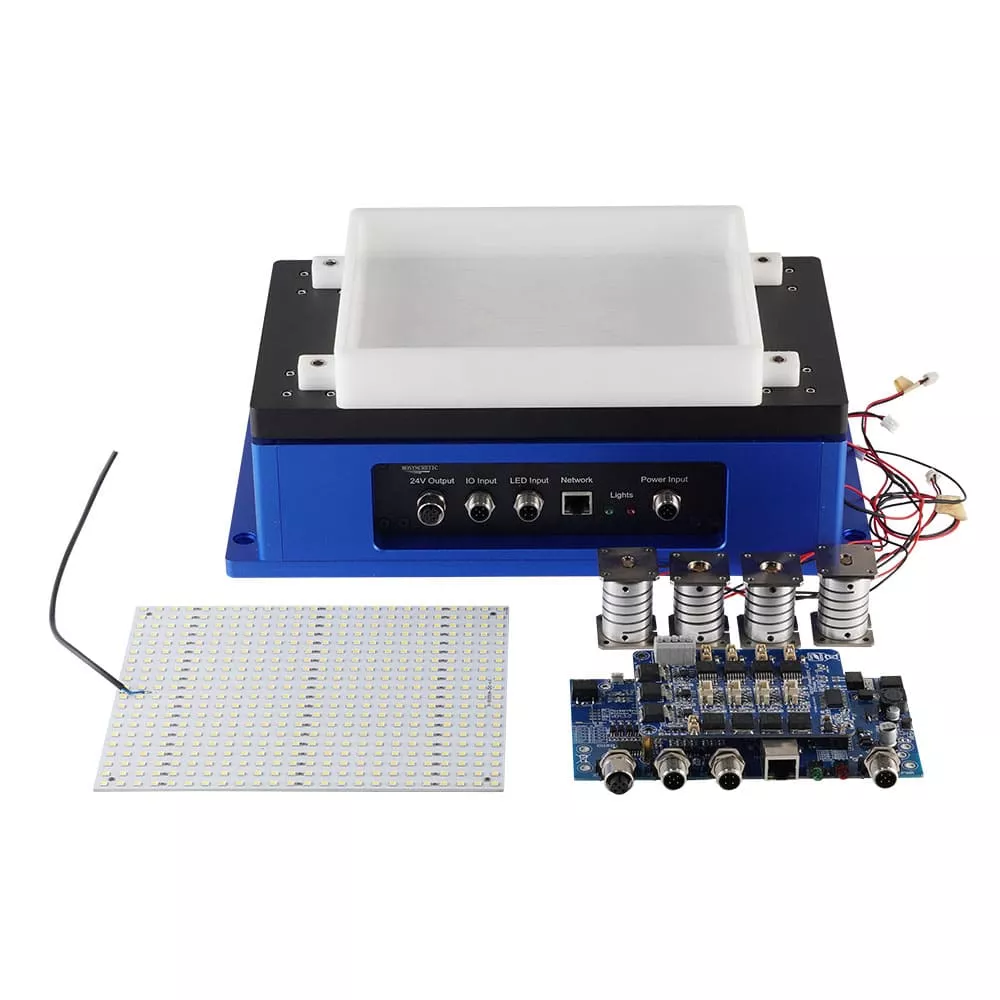Flexible Feeder
Flexible Feeder
- Overview
- Specs
WHAT IS FLEXIBLE FEEDER?
The flexible feeder is a vibrating plate compatible with a wide range of materials and parts. It can be used to disperse batches of small, irregular parts and can be fitted with visual picking and robotic retrieval systems. In an automated feeding process, the flexible feeder plays an essential role in moving parts from one station to the next.
Characteristics of Flexible Feeder

- Accurate positioning
Equipped with industrial vision positioning technology and integrated backlight structure (optional), parts can be accurately positioned on the surface of the vibrating plate for gripping, and the material plate can be removed and washed.
- Gentle vibration feeding of parts
Based on multi-directional vibration fitting technology, our MS series flexible feeder can control the movement of loose parts in any direction on the surface of the pick-up window.
With adjustable vibration amplitude and vibration mode, it gently fed the parts, without cyclic back-and-forth conveying of parts, reducing surface damage to a deficient level and without potential jamming.
- High reliability and long life
Based on frequency resonance fitting technology, without other mechanical power sources and transmission mechanisms, ensuring high reliability and long life.
- Easy to integrate, easy to configure
MS series flexible feeder parameter configuration software, graphic interface, easy to configure and integrate, can be easily integrated with industrial automation equipment in all kinds of mainstream PLC, and robot vision system production systems.
Flexible Feeder Working Principle
The flexible vibrating plate is also called flexible loading plate, flexible vibrating plate, flexible feeder, and so on. It is a small part of industrial automation production, 99% of the bulk material feeding arrangement.
Its working method is; first manual loading to the storage bin, the storage bin vibration replenishment to the flexible feeder plate. The flexible feeder can move the parts on the surface of the plate in any direction fast vibration scattering arrangement.
First, the manual material is added to the storage bin, which vibrates and replenishes the material to the flexible feeder tray; then, the flexible feeder can move the parts on the tray’s surface in any direction and quickly vibrate and disperse the arranged parts.
The next step is the vision system CCD photographing the appropriate part shape and position information in the pick-up window of the material tray and sending the coordinate data to the robot.
Finally, based on the coordinate data sent by the vision system, the robot grabs the parts from the surface of the feeder tray for array arrangement or assembly.
In the automation of feeding added vision system, the robot can solve the traditional vibrating plate feeding but can not solve the disorder, scattered, scratch, or distinguish the front and back side of the complicated feeding problems, like iFeedering.

Advantages of iFeedering Flexible Feeder
0.2mm or less thin parts feeding, the traditional vibration plate feeding, encounter thin class of easy to stack the film, can not be divided; and our flexible feeder using multi-way vibration to disperse parts, visual photo positioning, robot gripping, a good solution to the thin skin class of parts feeding problem.
The surface is easy to scratch the damaged electroplating products because the traditional vibration plate in the silo constantly cycles. The surface of its parts is easily scratched between the products and the material channel, and our flexible feeder visual material selection, without circular reciprocal feeding, has a clean grasp.
Shaped workpiece material selection, transmission vibration plate material selection relies on the geometric characteristics of the parts and quality distribution to achieve the selection of parts direction and sorting, when encountering shaped parts, can not be good and efficient sorting selection, and our flexible feeder based on visual selection of parts, the perfect solution to the problem of shaped workpiece feeding material selection.
Advantages of Flexible Feeding Tray

Based on the personalized structure of the customer’s product shape, we structure the design of the material tray (holes, slots, teeth, drawings, etc. This design can make the parts quickly and accurately be positioned to identify the gripping, reducing the waiting time for photos and significantly improving production efficiency.
- Highly versatile
Applicable to various small parts, complex geometric shapes, surface plating afraid of scratching, thin sheet type, and shaped parts.
- Flexible production
Can realize multi-species sharing and fast material switching.
- Low noise
No abrasion, no circular vibration of materials, no abrasion of materials, low noise, and no risk of material jamming.
- Precise positioning
Independently developed industrial vision positioning technology can precisely position the grasping, and the image positioning accuracy can reach ±0.05mm.
Our Model
MS-F150
Name | Parameter |
|---|---|
Size L*W*H | 199*119*182mm |
Tray Size | 150*98mm |
Weight | 6 KG |
Power Supply | DC24V/10A |
Move Type | Front / Back, Turn, Aggregate, Disperse |
Running Noise | <75dB |
Max. Load | 0.2 KG |
Min. Unit Weight | <50g |
Min. Unit Size | <75mm |
Feeder Controller | Built-in |
CCD / Pixel | 1200 / 120 million |
Backlight Color | White |
Cycle Time | 1.5~3s |
Communication Interface | Ethernet (TCP/IP) Modbus TCP Modus RTU |
Vision System | Mosyncretic Vision Option |
MS-F240
Name | Parameter |
|---|---|
Size L*W*H | 300*171*132mm |
Tray Size | 195*150mm |
Weight | 8 KG |
Power Supply | DC24V/10A |
Move Type | Front / Back, Turn, Aggregate, Disperse |
Running Noise | <75dB |
Max. Load | 0.5 KG |
Min. Unit Weight | <50g |
Min. Unit Size | <75mm |
Feeder Controller | Built-in |
CCD / Pixel | 1200 / 120 million |
Backlight Color | White |
Cycle Time | 1.5~3s |
Communication Interface | Ethernet (TCP/IP) Modbus TCP Modus RTU |
Vision System | Mosyncretic Vision Option |
MS-F380
Name | Parameter |
|---|---|
Size L*W*H | 499*257*307mm |
Tray Size | 325*254mm |
Weight | 15 KG |
Power Supply | DC24V/10A |
Move Type | Front / Back, Turn, Aggregate, Disperse |
Running Noise | <75dB |
Max. Load | 2 KG |
Min. Unit Weight | <50g |
Min. Unit Size | <75mm |
Feeder Controller | Built-in |
CCD / Pixel | 1200 / 120 million |
Backlight Color | White |
Cycle Time | 1.5~3s |
Communication Interface | Ethernet (TCP/IP) Modbus TCP Modus RTU |
Vision System | Mosyncretic Vision Option |
MS-F530
Name | Parameter |
|---|---|
Size L*W*H | 600*374*314mm |
Tray Size | 427*370mm |
Weight | 25 KG |
Power Supply | DC24V/10A |
Move Type | Front / Back, Turn, Aggregate, Disperse |
Running Noise | <75dB |
Max. Load | 3 KG |
Min. Unit Weight | <50g |
Min. Unit Size | <75mm |
Feeder Controller | Built-in |
CCD / Pixel | 2000 / 120 million |
Backlight Color | White |
Cycle Time | 1.5~3s |
Communication Interface | Ethernet (TCP/IP) Modbus TCP Modus RTU |
Vision System | Mosyncretic Vision Option |

